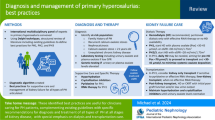Abstract
A 9.5-year-old girl, whose early symptoms were polyuria and growth retardation, is described. During the progression of her disease, hyperkalaemia developed out of proportion to the degree of renal insufficiency. Her fractional excretion of sodium increased from 3.3% to 35%, and her fractional excretion of potassium decreased from 55% to 22%. The plasma aldosterone level and plasma renin activity (PRA) were very high −290 ng/ml and 100 ng/dl per hour, respectively (normal range for this age 2.6–20.8 ng/ml and 1.2–2.7 ng/ml per hour, respectively). In an attempt to reduce these hormone levels, an acute and sustained saline load, captopril and peritoneal dialysis were used. Only the sustained saline load normalized the PRA, and only peritoneal dialysis sufficiently suppressed the plasma aldosterone level. Successful renal transplantation normalized both plasma aldosterone and PRA. This girl presents the unusual occurrence of pseudohypo-aldosteronism type I, during the course of familial juvenile nephronophthisis.
Similar content being viewed by others
References
Bernstein J, Gardner KD Jr (1978) Familial juvenile nephronophthisis — medullary cystic disease. In: Edelmann CM (ed) Pediatric kidney disease. Little Brown, Boston, pp 580–586
Schwartz GJ, Brion LP, Spitzer A (1987) The use of plasma creatinine concentration for estimating glomerular filtration rate in infants, children and adolescents. Pediatr Clin North Am 34: 571–590
Stalker HP, Holland NH, Kotchen JM, Kotchen TA (1976) Plasma renin activity in healthy children. J Pediatr 89: 256–258
Hiner LB, Gruskin AB, Baluarte HJ, Cote ML (1976) Plasma renin activity in normal children. J Pediatr 89: 258–261
Dillon MJ, Ryness JM (1975) Plasma renin activity and aldosterone concentration in children. BMJ 4: 316–319
Victorin L, Ljungqvist A, Winberg J, Akesson HO (1970) Nephronophthisis. A uremic disease with hypotonic urine. Acta Med Scand 188: 145–156
Popovtzer MM, Katz FH, Pinggera WF, Robinette J, Halgrimson CG, Butkus DE (1973) Hyperkalemia in salt wasting nephropathy. Arch Intern Med 132: 203–208
Van Collenburg JJM, Thompson MW, Huber J (1978) Clinical pathological and genetic aspects of a form of cystic disease of the renal medulla: familial juvenile nephronophthisis. Clin Nephrol 9: 55–62
Chagnac A, Zevin D, Weinstein T, Hirsch J, Levi J (1986) Combined tubular dysfunction in medullary cystic disease. Arch Intern Med 146: 1007–1009
Author information
Authors and Affiliations
Rights and permissions
About this article
Cite this article
Eisenstein, B., Davidovitz, M., Garty, B.Z. et al. Severe tubular resistance to aldosterone in a child with familial juvenile nephronophthisis. Pediatr Nephrol 6, 57–59 (1992). https://doi.org/10.1007/BF00856835
Received:
Revised:
Accepted:
Issue Date:
DOI: https://doi.org/10.1007/BF00856835




